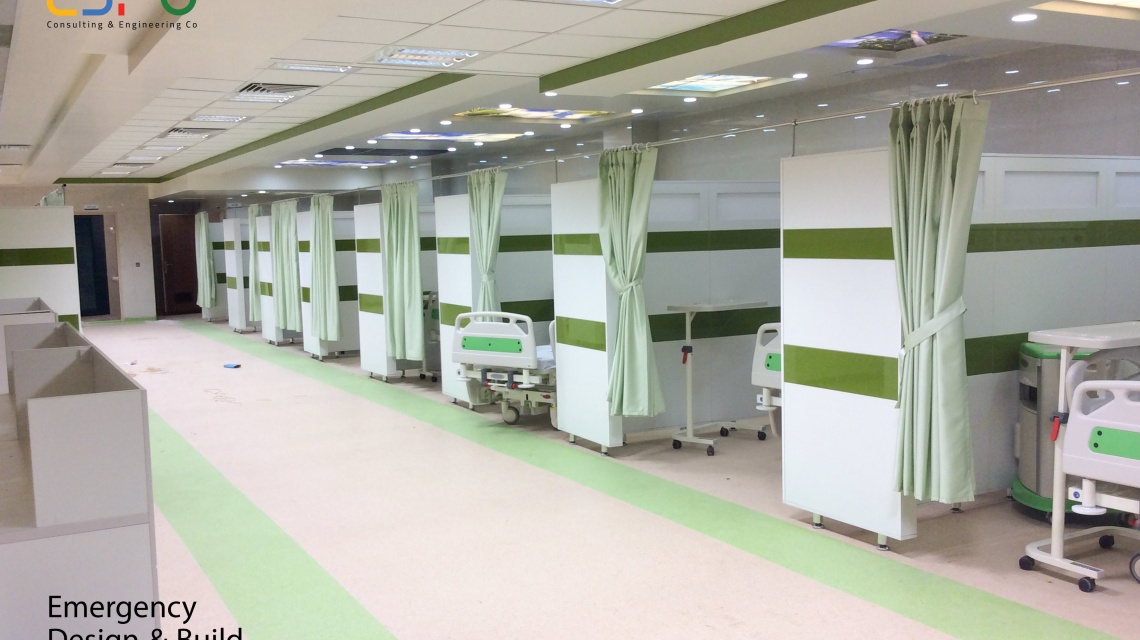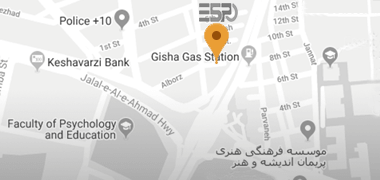
یکی از مهمترین بخشهای تخصصی در بیمارستانها و مراکز درمانی است که برای پاسخگویی به حوادث شیمیایی طراحی و تجهیز میشود. این بخشها نقش کلیدی در مدیریت و درمان بیماران مبتلا به مسمومیتها و آسیبهای ناشی از مواجهه با مواد شیمیایی خطرناک ایفا میکنند. از آنجا که حوادث شیمیایی میتوانند عواقب جدی و فوری بر سلامتی انسانها داشته باشند، وجود یک اورژانس شیمیایی با طراحی بهینه و استانداردهای بینالمللی اهمیت فراوانی دارد. شرکت اسپو بهعنوان پیشرو در طراحی و اجرای پروژههای درمانی، اولین و تنها اورژانس شیمیایی در ایران را طراحی و اجرا کرده است. این اورژانس که در بیمارستان بقیهالله قرار دارد، بر اساس آخرین استانداردها و الزامات بینالمللی احداث شده و نقش حیاتی در حفظ سلامت بیماران و پرسنل در برابر حوادث شیمیایی ایفا میکند. در این مقاله، به بررسی کاربردها، الزامات و نکات طراحی اورژانس شیمیایی پرداخته میشود.
1. کاربرد اورژانس شیمیایی اورژانس شیمیایی بهصورت ویژه برای مدیریت و درمان افرادی که در معرض مواد شیمیایی خطرناک قرار گرفتهاند طراحی شده است. این بخش از اورژانس بهطور مستقیم با تهدیداتی مانند نشت مواد شیمیایی صنعتی، حوادث تصادفی در محیطهای کاری، حملات شیمیایی و حتی مسمومیتهای خانگی سروکار دارد. کاربردهای اورژانس شیمیایی شامل موارد زیر است:
• درمان فوری مسمومیتهای شیمیایی: یکی از اصلیترین کاربردهای اورژانس شیمیایی، درمان مسمومیتهای شدید ناشی از تماس با مواد سمی و خطرناک است. این مواد میتوانند شامل گازهای سمی، مواد مایع و حتی ذرات شیمیایی باشند.
• پاکسازی و رفع آلودگی (دیکانتامیناسیون): در اورژانس شیمیایی، اولین قدم در درمان بیمار، پاکسازی مواد شیمیایی از روی بدن و لباسهای بیمار است تا از گسترش آلودگی به دیگران و مناطق اطراف جلوگیری شود.
• پایش مستمر بیماران: بیماران نیازمند پایش مستمر علائم حیاتی هستند، بهویژه در مواردی که با مواد شیمیایی مهلک مواجه شدهاند. پرسنل اورژانس شیمیایی باید قادر باشند بهسرعت وضعیت بیمار را ارزیابی و اقدامات لازم را انجام دهند.
2. الزامات طراحی اورژانس شیمیایی طراحی اورژانس شیمیایی نیازمند رعایت مجموعهای از استانداردها و الزامات خاص است که به حفظ ایمنی و بهبود عملکرد این بخش کمک میکند. این الزامات شامل موارد زیر میشود:
2.1 فضاهای پاکسازی و ایزوله یکی از مهمترین بخشهای اورژانس شیمیایی، فضاهای پاکسازی (دیکانتامیناسیون) است. این فضاها باید به گونهای طراحی شوند که بتوانند بیمارانی را که در تماس با مواد شیمیایی بودهاند، بهسرعت پاکسازی کنند. امکاناتی مانند دوشهای اضطراری، اتاقهای شستشو و تجهیزات محافظت فردی (PPE) در این فضاها ضروری است. همچنین باید اتاقهای ایزوله برای بیماران آلوده در نظر گرفته شود. این اتاقها باید دارای سیستمهای تهویه مطبوع ویژهای باشند که از گسترش آلودگی به سایر نقاط جلوگیری کند.
2.2 سیستم تهویه و کنترل آلودگی سیستم تهویه در اورژانس شیمیایی اهمیت بسیاری دارد. تهویه با فشار منفی یکی از استانداردهای ضروری در این بخش است که از خروج هوای آلوده به بخشهای دیگر جلوگیری میکند. همچنین باید از فیلترهای پیشرفته HEPA برای تصفیه هوای آلوده استفاده شود. این سیستمها باید به گونهای طراحی شوند که مواد شیمیایی معلق در هوا را بهسرعت جذب کرده و هوای پاک را در فضا حفظ کنند. سیستمهای فیلتراسیون باید بهطور مداوم بهروزرسانی و نگهداری شوند تا از عملکرد صحیح آنها در شرایط بحرانی اطمینان حاصل شود.
2.3 دسترسی آسان و ایمنی پرسنل برای مقابله با شرایط بحرانی شیمیایی، اورژانس شیمیایی باید بهگونهای طراحی شود که دسترسی سریع به تجهیزات و فضاهای پاکسازی فراهم شود. همچنین پرسنل این بخش باید بهطور کامل به تجهیزات حفاظتی و لباسهای مخصوص مجهز شوند تا در زمان پاکسازی و درمان بیماران، از خطرات احتمالی محافظت شوند. دربهای هوابند و سیستمهای کنترل دسترسی باید در این بخش وجود داشته باشد تا از ورود و خروج غیرمجاز افراد و انتقال آلودگی جلوگیری شود.
2.4 مواد مقاوم در برابر مواد شیمیایی تمامی سطوح، دیوارها و کفپوشها در بخش اورژانس شیمیایی باید از مواد مقاوم در برابر شیمیاییها ساخته شوند. این مواد باید بهراحتی قابل شستشو و ضدعفونی باشند و در برابر تماس با مواد سمی و خورنده مقاوم باشند. استفاده از این مواد به کاهش خطرات ناشی از نشت مواد شیمیایی و آلودگی محیط کمک میکند.
3. نکات طراحی اورژانس شیمیایی طراحی بخش اورژانس شیمیایی نیازمند در نظر گرفتن چندین فاکتور مهم است که باید با دقت اجرا شود. شرکت اسپو با تجربه گسترده در زمینه طراحی و اجرای پروژههای درمانی، بهعنوان اولین و تنها مجری اورژانس شیمیایی در ایران، نکات زیر را در طراحی اورژانس شیمیایی بیمارستان بقیهالله رعایت کرده است:
3.1 تقسیمبندی فضاها بخش اورژانس شیمیایی بهطور کلی به چندین بخش مجزا تقسیم میشود:
• اتاقهای پاکسازی (دیکانتامیناسیون): برای شستشو و حذف مواد شیمیایی از بدن بیماران.
• اتاقهای ایزوله: برای بستری بیماران آلوده. • فضاهای مشترک: برای درمان و پایش بیماران غیر آلوده و ایمن. این تقسیمبندی به کاهش ریسک انتقال آلودگی و بهبود جریان کاری کمک میکند.
3.2 موقعیت استراتژیک اورژانس اورژانس شیمیایی باید در مکانی قرار گیرد که دسترسی به آن سریع و آسان باشد. در بیمارستان بقیهالله، این بخش به گونهای طراحی شده است که در نزدیکی ورودیهای اصلی اورژانس عمومی قرار دارد و از مسیرهای مجزا برای انتقال بیماران استفاده میشود.
3.3 فضاهای مجهز برای پرسنل پرسنل اورژانس شیمیایی نیازمند فضاهایی مخصوص برای تعویض لباسهای محافظتی و استراحت در شرایط ایمن هستند. در طراحی اورژانس بیمارستان بقیهالله، اتاقهای ویژهای برای این منظور در نظر گرفته شده است که از دسترسی سریع به تجهیزات حفاظتی و امکان شستشو برخوردار هستند.
3.4 سیستمهای هشدار و کنترل بحران در اورژانس شیمیایی، باید سیستمهای هشداردهنده پیشرفتهای نصب شود که در زمان بروز حوادث شیمیایی، پرسنل و بیماران را از خطرات مطلع کند. این سیستمها شامل آژیرهای هشدار، سیستمهای اطلاعرسانی داخلی و صفحات نمایش وضعیت خطر هستند که به مدیریت بحران کمک میکنند.
4. شرکت اسپو: پیشرو در طراحی اورژانس شیمیایی شرکت اسپو با سابقهی طولانی در طراحی و اجرای پروژههای درمانی و بیمارستانی، موفق به طراحی و اجرای اولین و تنها اورژانس شیمیایی در ایران شده است. این اورژانس در بیمارستان بقیهالله قرار دارد و با رعایت تمامی استانداردهای بینالمللی و الزامات ایمنی طراحی شده است. شرکت اسپو با بهرهگیری از تیمهای تخصصی در زمینه معماری، مهندسی و مدیریت پروژه، قادر به ارائه خدمات جامع در زمینه طراحی و اجرای بخشهای تخصصی بیمارستانی است. اجرای موفق اورژانس شیمیایی در بیمارستان بقیهالله، نشاندهنده تعهد و توانایی این شرکت در ارائه پروژههایی با بالاترین استانداردهای جهانی است.

















